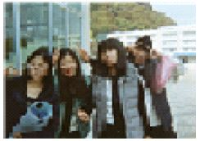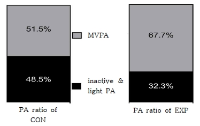
Recently, there have been diverse types of physical activities supported by government policy in S. Korea. However, these activities may not be effective if they do not reach to moderate to vigorous level. This study designed school physical education system based on SPARK program, which include traditional physical education, sports club based physical activity, after school physical activity, and Saturday physical activity, to evaluate its effectiveness associated with physical fitness and empirical meanings of physical activity. This study employed a mixed method research paradigm for better understanding. Among various mixed method paradigm stances, this study employed "blending strategy" for complementary analysis. First of all, the effectiveness in health condition was evaluated by quantitative data. Specifically, physical fitness and lifestyle were analyzed by Helmas, IPAQ, and Accelerometer respectively. Second, empirical meanings of physical activity were analyzed by both Photovoice and in-depth interview which are qualitative research method. The result of this study first showed that a specially designed school physical activity program based on the SPARK contributed to improve students' physical fitness and lifestyle as well, however, there were important differences between male and female students. Second, physical achievement, alteration of spatiotemporal meaning, and change of societal relationship emerged as important themes. Further, these themes showed that they played an important role to maintain students' motivation in physical activity and consequently physical activity promotion was invigorated in school. Based on these results, we synthesized investment factors and process factors and outcome factors respectively. Finally, we suggested alternative teaching methods and suggestions for following research to overcome gender issues.










PURPOSE This study aimed to analyze physical activity (sedentary, light, moderate to vigorous physical activity [MVPA]) characteristics of middle school students based on region (urban and rural) and sex. METHODS Data were collected from 216 students across 6 middle schools located in medium-sized urban (3 schools) and rural areas (3 schools), and the relevant physical activity was measured using a three-dimensional accelerometer (GT3X model). The collected data were inputted into the SPSS 20.0, and descriptive analysis and two-way ANOVA based on region and gender were performed (<.05). RESULTS The descriptive statistical analysis resulted in the following achievement rate of the physical activity standard (MVPA 60 minutes/day): 9.4%. The two-way ANOVA showed that the main effect according to gender was found in sedentary activity (F=5.258), light activity (F=6.790), and MVPA (F=32.274); furthermore, the main effect according to region was found in light activity (F=10.888) and MVPA (F=7.876). Interaction effect according to region and gender was found at all intensities, and the gap between rural and urban in male students was larger compared to that of female students. CONCLUSIONS After COVID-19, the level of physical activity among adolescents has worsened; this study found the problem of "decrease in physical activity; increase in sedentary activity" to be more serious among male students in urban areas.
PURPOSE The purpose of this study was to investigate the association of physical activity level with insomnia severity (Normal, Subthreshold, Moderate and Severe) in adolescents and to use it as a basis for insomnia prevention. METHODS This study was conducted on a cohort of 50 adolescents under the age of 20 (19 males, 31 females) recruited from Hospital N in Incheon, Korea. Participants were categorized into groups according to the severity of insomnia in both males and females using the Korean version of the Insomnia Severity Index-Korean (ISI-K). The Korean version of the International Physical Activity Questionnaire was also used to calculate participants’ weekly moderate and vigorous physical activity. RESULTS The participants’ characteristics did not differ by insomnia severity in males, but there were significant differences in weight (p=.008), BMI (p=.019), SBP (p=.004), and DBP (p=.019) in females by insomnia severity. In male adolescents, there was no significant difference in the amount of physical activity by insomnia severity, but there was a trend toward decreased amount of physical activity with increasing severity. Among female adolescents, there were significant differences in the amount of physical activity by insomnia severity: moderate (p<.05), high (p<.05), and moderate-high (p<.05). In the unadjusted model, adolescents who did not meet the recommended amount of physical activity (150 minutes per week) were more likely to have insomnia (OR=4.67, 95% CI=1.34–16.24) than those who met the recommended amount of physical activity. The model after adjusting for covariates (gender and body mass index) also showed an association between the recommended amount of physical activity and insomnia (OR=3.94, 95% CI=1.17–13.28). Negatice correlations was found between insomnia index and moderate-to-vigorous physical activity (r=–.357, p=.013). CONCLUSIONS Adolescents are approximately 4.67 times more likely to suffer from insomnia if they do not meet physical activity recommendations, and there was a negative correlation between the insomnia index and moderate-to-vigorous physical activity, suggesting that physical activity should be increased to reduce the insomnia index.
PURPOSE The purpose of this study was to compare the dynamic postural control of youth athletes with and without a history of lateral ankle sprains. METHODS Twenty-eight youth athletes (14 lateral ankle sprain, 14 healthy control) participated in this study. All participants answered the Foot and Ankle Ability Measure questionnaire and were subject to the Star Excursion Balance Test (SEBT) for dynamic postural control evaluation to collect the joint angles of the lower extremity, a center of pressure (COP) path, and COP velocity. Independent sample t-test or Mann-Whitney U-test were performed to analyze the difference between the groups. RESULTS The lateral ankle sprain group (LAS) was found to have a long experience in participating in sports, and low Foot and Ankle Ability Measure scores were identified when compared to the healthy control (CON; p<0.05). LAS was observed with a short reach distance, less hip flexion, and dorsiflexion angles during the anterior direction of SEBT when compared to CON (p<0.05). Furthermore, LAS showed a slower anteroposterior and mediolateral center of pressure velocities in the posteromedial aspect of SEBT and a slower anteroposterior COP velocity in the posterolateral aspect of SEBT when compared to that of CON (p<0.05). There were no differences between the groups with respect to the other variables (p>0.05). CONCLUSIONS Based on these results, decreased anterior reach distance of SEBT may be affected by changing the dynamic posture control strategy of the lower extremity joint on the sagittal plane in LAS.
PURPOSE This study aimed to identify movement pattern differences in the running of youth soccer players with and without lateral ankle sprain (LAS) histories. METHODS A total of 12 participants were recruited and assigned to the LAS group or the control group. All participants were assessed for anthropometric data, and they filled in the subjective ankle function questionnaires. Then, reflective markers were attached to their bodies, and they were instructed to run at the preferred speed on the 9-m runway thrice. 3D joint angles for ankle, knee, and hip joints were exported, and their mean values and 95% confidence intervals were calculated. Ensemble curve analysis was conducted to compare running kinematics between the groups. RESULTS The LAS group exhibited fewer dorsiflexion angles and more inversion angles compared to the control group. Excluding the dorsiflexion deficits and more inverted ankles, there were no significant differences between the groups. CONCLUSIONS Although the ankle kinematic patterns found in this paper are not considered LAS risk factors, it will be able to identify precise LAS risk factors with prospective design (e.g., lower extremity movement patterns) as well as intrinsic risk factors.
The purpose of this study was to examine the relationship of obesity index, fitness and cardiovascular risk index in middle and high school students. Obesity index, fitness score and cardiovascular risk index were measured from 1,044 middle and high school students. The results of relation between obesity index and fitness showed that the higher obesity index had significantly lower fitness score for both boys and girls (boys: p<0.001, girl: p<0.05) The results of relation between obesity index and cardiovascular risk index indicated that the higher obesity index had significantly higher cardiovascular risk index for both boys and girls (boys: p<0.001, girl: p<0.001). Moreover, The lower fitness index showed significantly higher cardiovascular risk index regardless of gender in middle school students (boys: p<0.001, girl: p<0.01). Therefore, the results of this study indicated that obese adolescents had the lower fitness level and high possibility of cardiovascular risk.
PURPOSE The purpose of this study was to analyze the level and characteristics of physical activity (sedentary, light, and MVPA) of high school students according to physical education (PE) class (DWPE: days with PE class, DNPE: days with no PE class) and sex. METHODS Data were collected on 147 students (65 male and 82 female) from four high schools in Seoul city, and physical activity was measured using a three-dimensional accelerometer. The collected physical activity data were input into SPSS 25.0, and the descriptive analysis and two-way ANOVA according to PE class and sex were performed. RESULTS The descriptive statistical analysis showed that 31% (40.7% male and 23.4% female) of participants met the recommended physical activity durations (MVPA of 60 min/day). In the two-way ANOVA, sedentary activity, light activity, and MVPA showed statistically significant main and interaction effects according to PE class and sex. According to the results of the interaction effect analysis, the gap in physical activity between DWPE and DNPE was large in male students. For male students, light activity and MVPA significantly increased on the day of the PE class, and sedentary activity significantly decreased. However, for female students, DWPE and DNPE did not differ significantly in all levels of physical activity. CONCLUSIONS In conclusion, the level of physical activity of Korean high school students was relatively low, and the effect of daily-life physical activity in the PE class was limited to male students. Accordingly, an alternative should be introduced to increase the physical activity of female high-school students through PE classes.
PURPOSE Sport pedagogy (SP) has established itself as a subdiscipline in Human Movement Studies since the 1970s. It has become an academic labyrinth as a result of its rapid flourishing. Most researchers are extremely confused about this disorderly research complex. This study aimed to evaluate the characteristics of SP in stages in the western (mostly English speaking) countries. METHODS Analysis of literature published in English from 1990 to 2022. RESULTS The developmental versions were divided as follows: SP1.0 is positivistic in nature, SP2.0 is multi-paradigmatic as it includes all paradigms, and SP3.0 (current version). Many academic journals have been launched, and a variety of books on divergent topics are being published. Currently, research has exploded. In SP3.0, research performed by British scholars are notable in terms of number and quality, overpowering those by scholars in the USA and other countries. Youth sport and sport coaching are regarded as new legitimate areas. Additionally, signs for SP4.0 have been indicated. CONCLUSIONS In order to find way outs in the SP labyrinth, it is necessary to recognize the current research trends in international SP.

Purpose The purpose of this study is to measure the daily physical activity of male and female middle school students according to the period (VD: vaction day, SNPE: school day no PE, SPE: school day with PE) by using 3-axis accelerometer, and to compare the characteristics of adolescent physical activity according to gender and period. Methods The subjects were 130 middle school students (68 male, 62 female students). Data collection was performed using a 3-axis accelerometer(GT3X model, ActiGraph). Collected data were converted into time by intensity and rate using physical activity analysis program (Actilife v6.11.9) and analyzed by statistical program (SPSS 25.0). One-way ANOVA and independent sample t-test were used for statistical analysis. Tukey's HSD was used as a post analysis. The statistical significance level was .05. Results As a result, during each periods(VD, SNPE, and SPE), except for MVPA(moderate to vigorous physical activity) time on SPE, sedentary and MVPA time were significantly higher in female students, and low intensity and total physical activity time were significantly higher in male students. For male students, total physical activity time was higher in the order of SPE, SNPE, and VD, and for female students, physical activity time during the semester(SNPE and SPE) was significantly higher than VD. For male students, MVPA time was significantly high in order of SPE, SNPE, and VD, and for female students, it was high in order of SPE, SNPE, and VD but only significant difference occurred between SPE and VD. For both male and female students, sedentary time was high in the order of VD, SNPE, and SPE, but the sedentary time during vacation was significantly higher than during the semester. Conclusions When summarizing the results, first, it was confirmed that school and physical education classes as a physical activity space play a significant role in physical activity, especially MVPA, of male and female middle school students, second, the physical activity effect of physical education class was found to be more effective in male students. Based on the results of this study, it is necessary to conduct studies on various grades and to explore various factors affecting physical activity in a complex way.




Active participation in Moderate to Vigorous Physical Activity(MVPA) is the indicator of healthy development for adolescents. However, Korean adolescents’ MVPA have continuously declined, and Korean adolescents have lower levels of MVPA compared to adolescents in other countries. Considering this issue, the purpose of this study is to examine the effectiveness of SPARK M-SPAN program to promote adolescents’ MVPA in P.E. classes and to understand how the promotion of adolescents’ MVPA occurs. To collect data, this study used Sequential Mixed Method and GT3X accelerometers. A total of 168 adolescents (84 in an experimental group and 84 in a control group) participated in this study for the quantitative data analysis, and six students and a teacher were interviewed for the qualitative data analysis. Paired t-test showed that students in SPARK P.E. classes experienced the significant decreases of sedentary behaviors(-339.6 sec) and low intensity P.A.(-96.9 sec) at p<.05 and the significant increases of moderate(+99.3 sec), vigorous(+252.4 sec), and very vigorous intensity P.A.(+84.7 sec) regardless of gender difference at p<.05 except for female students’ moderate intensity P.A.. The qualitative data analysis showed that SPARK classes gave students positive learning environments and led them to experience enjoyment and achievement-orientated learning Key teaching strategies of SPARK program and future research suggestions were provided in the discussion section.

